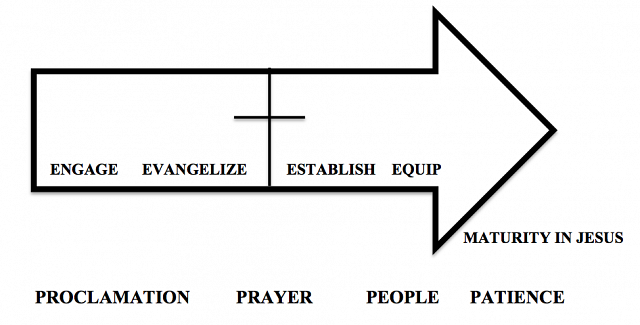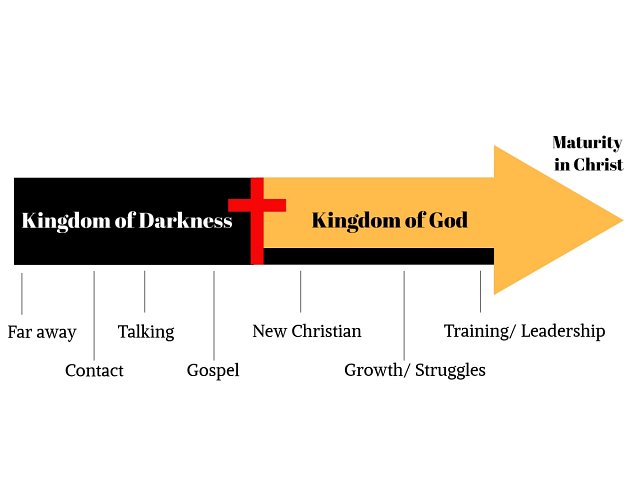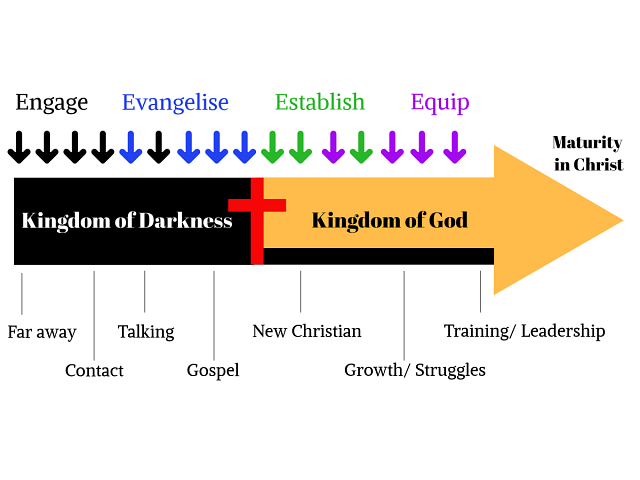Sunday 17th February 2019
For the next few weeks we’re looking at how to make disciples. A Christian disciple is someone who learns Jesus – who learns what Jesus said and did, and then does the same.
We’re using a diagram which hopefully helps us understand how to go about that, and that it doesn’t have to be difficult. None of us has to find someone who doesn’t believe in God, explain God, convert them and teach them everything the bible says. There are very few people who are gifted enough to be able to go right through that whole process with someone. However, each of us is expected to do a bit of that process.
Remember the diagram:

 The left is furthest from God, so we want to try and move people to the right. Here’s a more complex version of the diagram:
The left is furthest from God, so we want to try and move people to the right. Here’s a more complex version of the diagram:

Kingdom of darkness -
John 3:19This is the verdict: Light has come into the world, but people loved darkness instead of light because their deeds were evil.
The bible is quite clear that the majority of people are living in darkness – and they don’t know it. There are lots of people who live perfectly decent, ordinary lives but without knowing Jesus they are still in darkness. In a way you can understand it – if you have everything you need in life, maybe not everything you want but things are ok, it’s reasonable to ask what faith brings into that mix. If, in one sense, you have everything you need, why do you need God?
John 12:46I have come into the world as a light, so that no one who believes in me should stay in darkness.
John 10:10The thief comes only to steal and kill and destroy; I have come that they may have life, and have it to the full.
No diagram is perfect and this shows where our four E words fit in.

Of course, all four are going on at the same time and the continuation of that line reminds us that even those of us who have ‘seen the light’ and are trying to follow Christ need to be reminded that we have been forgiven, that we have received the unmerited grace of God and that we have to give up those things that belong to the darkness that still have a hold on us.
Today we’re thinking about engage– that is our interactions with people who are further from God. We do a fair bit of this as a Christian community – knitting angels at Christmas; food bank; stall at Prom Day; Messy Church etc. These are ways we try to show the love of God in different ways so that we might get the chance to answer the question, “Why are you doing this?” Some of them are to people who know nothing about God and with whom we have no ongoing relationship, and others are to people who have expressed more interest.
In the early years of the first century the people of Israel were waiting for the Messiah to come. They were waiting for the person the prophets had spoken of to come and set the people free. A man then appeared in the wilderness. He was an odd character, living off insects and honey and wearing camel hair clothes! He started baptising people and calling them to repentance. There was great excitement and people gathered to hear what he had to say. He made it clear however that he wasn’t the person that they were looking for, instead, he was the one called to prepare the way. This man, of course, was John the Baptist.
In our reading today we saw people who were at the contact/talking area of our diagram. They didn’t know God, but they were intrigued enough by this weird preacher who lived out in the desert to go and see what he was saying. They were interested enough in what he was saying to spend time with him, finding out a bit more. And that’s what the contact/talking area is about – it’s about building relationships, spending time with people, sharing and building trust and friendship.
In the short section before our reading today John the Baptist identifies Jesus as the ‘Lamb of God’ but there is no reaction from people around him. Then, our reading starts with, John 1:35The next day John saw Jesus coming toward him and said, “Look, the Lamb of God, who takes away the sin of the world!
Two of them decide to follow Jesus. They knew from what John the Baptist had said that Jesus was important. They could have just wanted to be seen with Him so that they could look important as well. They could have been like the Pharisees who were suspicious of Jesus, and only wanted to get close to Him, to discover what he was up to, and to spoil His plans. There could have been many other reasons and so Jesus asks them this very important question.
In the reply of the two disciples we see their heart. They firstly call Jesus, ’Rabbi’, meaning teacher, declaring that they want to hear what he has to say. In giving Jesus this title they display a small but important understanding that Jesus may have something important to teach them. They continue to ask the question, ’where are you staying?’ The disciples were making it clear that they wanted to get to know Jesus more and to spend time with Him. It is this declaration that they believe Jesus is somebody worth spending time with, that causes Jesus to tell them to come along and spend time with him. Notice he doesn’t go straight to everything the scripture teaches about the Messiah and say, “That’s talking about me.” Bringing people to God doesn’t often start with a random encounter and a full explanation of the whole plan of salvation from Genesis to Revelation – it usually starts with some sort of relationship that leads to an invitation or conversation.
The author, John, records that they spent that day with Him and that the time was the tenth hour. There may be other reasons for John to have recorded the time, but I believe that one of these reasons was because it was a life-changing experience. There aren’t many of us who don’t remember what we were doing on September 11th 2001, because it was a really significant moment in modern history. In the same way, this first encounter with Christ was something that John would remember for the rest of His life.
In the next few verses, we find these disciples eager to spread the word of who they had found. Andrew brings his brother Peter to Jesus, and after Philip encounters Jesus, he brings Nathanael. Here we see that one of the first signs that somebody has had an encounter with Jesus is a desire to share that experience with other people. All the disciples are called to follow Jesus.
We can see from Jesus’ encounter with Nathanael, that He knows us before we know Him. Nathanael believes in Jesus when he has this revelation. Jesus, however, tells Him that he will see much greater things than this. Reading on through the next three chapters of John we find that that is exactly what happens. The disciples follow Jesus and He reveals more and more about himself. They witness the miracle of the water into wine, the cleansing of the temple, the healing of the official's son and how Jesus deals with both the highly esteemed and despised people of this world. They have been called to follow Jesus and then put more and more faith in Him.
There is something a little strange about our story today and the next sections of John’s gospel – Matthew, Mark and Luke don’t record these earlier encounters that Jesus had with His disciples. In the other Gospels the first we read of Jesus, and His relationship with the disciples, is when he calls them to leave their boats. We know that this occurs sometime later, as Mark records that it happens after John the Baptist has been put in prison. I want to look at these accounts and why they only start to record the relationship between Jesus and his disciples from this point onwards. I am going to read from Luke, as Matthew and Mark are summarised versions of the same account.
Luke 5:1-11
One day as Jesus was standing by the Lake of Gennesaret, the people were crowding around him and listening to the word of God.2 He saw at the water’s edge two boats, left there by the fishermen, who were washing their nets. 3 He got into one of the boats, the one belonging to Simon, and asked him to put out a little from shore. Then he sat down and taught the people from the boat.
4 When he had finished speaking, he said to Simon, “Put out into deep water, and let down the nets for a catch.”
5 Simon answered, “Master, we’ve worked hard all night and haven’t caught anything. But because you say so, I will let down the nets.”
6 When they had done so, they caught such a large number of fish that their nets began to break.7 So they signalled their partners in the other boat to come and help them, and they came and filled both boats so full that they began to sink.
8 When Simon Peter saw this, he fell at Jesus’ knees and said, “Go away from me, Lord; I am a sinful man!”9 For he and all his companions were astonished at the catch of fish they had taken,10 and so were James and John, the sons of Zebedee, Simon’s partners.
Then Jesus said to Simon, “Don’t be afraid; from now on you will fish for people.”11 So they pulled their boats up on shore, left everything and followed him.
Remember when you read this passage, and its equivalent in Matthew and Mark, that Jesus has already known the disciples for a while and that they have seen Him perform miracles. In fact, it is suggested, in the way that Jesus just gets into Simon’s boat and asks Him to push away from the side without Simon muttering any words of discontent. When Jesus tells Simon to throw his nets back in, we see in Simon’s reply a suggestion that Simon knows enough about Jesus to agree, albeit reluctantly. I’ll do it because you say so – the relationship is already established and so there is a degree of trust.
What is it about this account that causes three out of the four gospel writers to consider it such an important moment in the relationship between Jesus and his disciples, that they don’t feel the need to include anything before it? To answer that it is worth remembering that up until this point the disciples have been spending time with Jesus but haven’t been directly affected by any of His miracles, nor taken part in any of them. They also haven’t had to give anything up. Here we see the stepping stone between simply following Jesus, and becoming one of His disciples. Jesus is about to take this group of men onto the next level.
Of course, it doesn’t stop there. This is only the start of a long process – they still don’t really understand who Jesus is, or what he is going to do. It’s not really until Pentecost when the Holy Spirit comes that it begins to become clear. So we see the process unfolding. A relationship is established with people who show some interest, trust is built, a more serious conversation ensues and there is enough interest to take the next step. Surely if it is good enough for John the Baptist and Jesus it’s good enough for us! Let’s go and, in obedience to the command of Jesus, make disciples.




